The final report is a key component of any PiT Count. There are many ways that count data can be effectively communicated but most PiT Count reports share common elements. The most effective PiT Count reports are concise, descriptive and easily understood by a wide-range of audiences.
A Focus on Youth
Youth Count reports are much like PiT Count reports, with the obvious exception that Youth Count reports have the added task of outlining the unique causes and consequences of youth homelessness. Your local Youth Count report is not only an opportunity to share the results of the count, but to inform key stakeholders, the media and the public about the issue of youth homelessness. The COH recommends that you include the following sections in your Youth Count report.
TABLE 12. COMPONENTS OF A YOUTH COUNT REPORT
|
The Count |
Based on the results of your analysis, you should provide communities with the number of youth that were found to be experiencing homelessness during the count. You must clearly communicate that the count represents the minimum number of homeless youth in your community. Certain forms of homelessness, such as couch-surfing, are not accurately captured through the youth count methodology. Similarly, youth living in unsheltered environments may go to great lengths to remain unseen. |
|
Key Demographics |
Provide a summary of key demographics (ex. percentage of Indigenous and newcomer youth) and significant findings. |
|
Acknowledgements |
Acknowledge the contributions of all Youth Count partners, including funders, participating agencies, emergency services. |
|
Definition of Homelessness |
Be sure to include a definition of homelessness. It is important for readers to understand that the experience of homelessness covers a vast range of living situations. Indicate which types of homelessness the Youth Count includes, and which types are beyond the scope of the exercise. For more information, refer to the Canadian Definition of Youth Homelessness. |
|
Methodology |
Briefly explain your methodology, including any limitations or unusual circumstances that could have affected data collection. Provide information on the number of volunteers that attended training and participated in the count. If you see merit in providing a detailed description of your methods, include such information in an appendix. |
|
Community Information |
Information about your community, including average housing prices, vacancy rates, annual shelter use and other housing and homelessness indicators can provide context to the Youth Count data. |
|
Results |
The data analysis and results should form the bulk of the Youth Count report. Use graphs and visual representations to make the data clearly understood. Where appropriate, contextualize the data. Consider how your results compare to other research on youth homelessness. |
|
Recommendations for Future Counts |
For the benefit of other communities and future count organizers in your community, include a section with key learning and recommendations for future counts. Solicit input from the Youth Count Committee and the Youth Subcommittee on what worked well and where there are areas for improvement. |
|
Appendices |
We recommend, at minimum, that you include your Youth Count survey in an appendix. It is helpful for other communities as they design their own Youth Count survey. |
|
Helpful Resource Examples of PiT Count reports from other communities can be found on the COH Workspace on Homelessness. |
Other Tips:
-
Reiterate, throughout the report, that the Youth Count yields the minimum number of youth experiencing homelessness in your community.
-
The Youth Count report should be engaging and easily read. Though some technical information is required, use plain language wherever possible.
-
Ensure that your report is visually engaging. Reports with visual interest and design elements are received more widely than those that are more academic in nature. Remember – the Youth Count is an opportunity for engagement! Your Youth Subcommittee may have helpful input on the look and the feel of the report.
-
Prepare a press release to accompany your final report. Include key messages, quotes from stakeholders and youth and a clear explanation of what the count does and does not cover. This will ensure that your messaging is clear, consistent and interpreted correctly.
-
Circulate widely! Develop a communications plan. Who will receive the report? Will you hold launch event? How will you ensure that survey participants have the option to receive the final report?
A Note on Reporting Hidden Homelessness
Typically, the PiT Count methodology does not capture hidden homelessness. The Youth Count, though modified to capture at least some of this population, is likely to miss those that are entirely unconnected from services. This will result in an undercount. As a result, hidden homelessness numbers should be communicated carefully. The COH proposes two different ways to communicate data on couch surfing youth:
THE AGGREGATED APPROACH

The aggregated approach combines all living situations into a single count. The unsheltered, emergency sheltered and provisionally accommodated populations are combined into a single number that is reported as the count. The aggregated approach is most appropriate where couch surfing makes up a significant portion of the total Youth Count sample.
THE DELINEATED APPROACH

The delineated approach keeps the hidden homelessness numbers separate from the unsheltered, emergency sheltered and transitional housing numbers. The “count” and the survey data are analysed separately. For more information on the benefits of the delineated approach, refer to the COH Webinar on Reporting Hidden Homelessness.
Building Alignment: Tips & Strategies
Prior to data collection, carefully consider how the results of the general PiT Count and Youth Count will be communicated. While it is possible to publish a combined report, we recommend that you release a discrete report on the experiences of homeless youth. Work with general PiT Count organizers to ensure that all count reports are consistent and coordinated.

